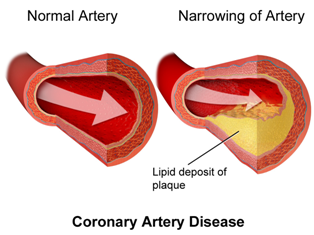Symptoms
The symptoms associated with coronary heart disease may be pronounced, but it can also be present without any noticeable symptoms.
Chest pain (angina) - This is the most common symptom, and it results from the heart not getting enough blood or oxygen. The intensity of the pain varies from person to person.
Chest pain may be typical or atypical.
Typical chest pain is felt under the sternum (breast bone) and is characterized by a heavy or squeezing feeling. It is precipitated by exertion or emotion, and it is relieved by rest or nitroglycerin.
Atypical chest pain can be located in the left chest, abdomen, back, or arm and is fleeting or sharp. Atypical chest pain is more common in women.
Other symptoms includes
(Shortness of breath) - If the heart is not pumping enough blood to circulate in the body, shortness of breath may be accompanied by swollen feet and ankles. |



